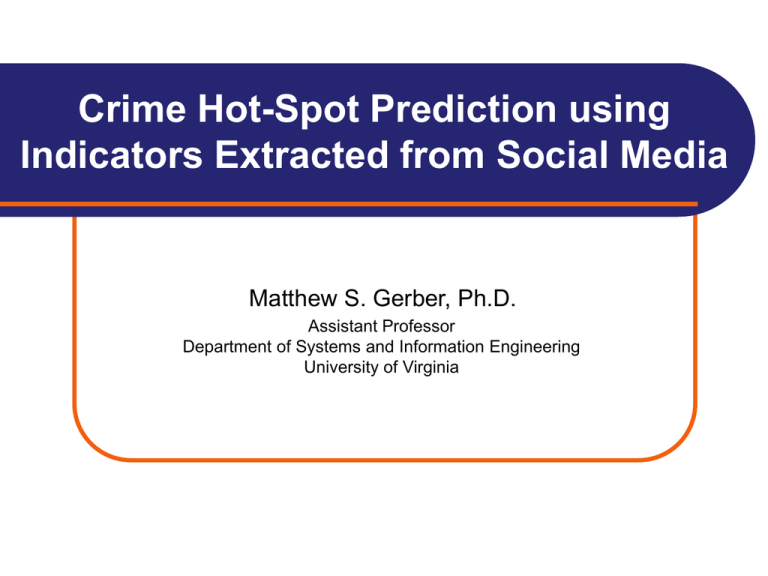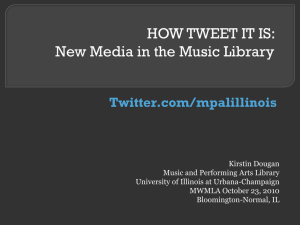
Crime Hot-Spot Prediction using
Indicators Extracted from Social Media
Matthew S. Gerber, Ph.D.
Assistant Professor
Department of Systems and Information Engineering
University of Virginia
IACA Presentations on Social Media
– The Modern Analyst and Social Media (Woodward)
– Impacts of Social Media on Flash Mobs and Police
Response (Ramachandran)
– Social Media Tools for Situational Awareness (Mills)
– Fighting Underage Drinking through Hotspot
Targeting and Social Media Monitoring (Fritz)
– Social Media for Crime Analytics in Undercover
Investigations 2.0 (Machado)
– Advancing Intelligence-Led Policing through Social
Media Monitoring (Roush)
2
Contributions
• Analysis
– What might Twitter add to environmental risk terrains?
• Automation
– No manual analysis of tweets
– No preconceived notions of what is salient for crime
• Scale
– 800,000 tweets/month; 25,000/day
– 1 prediction takes 1 hour on 1 CPU core (scales linearly)
• Predictive performance
– Comparisons with KDE and RTM
3
Intended Audience
• Machine learning & data mining
– Logistic regression, random forests, etc.
• Risk Terrain Modeling
• Density modeling
• Social media analytics
• Geographic information systems
4
Outline
•
•
•
•
•
•
•
Static Environments and Dynamic Activities
Basic Concepts
Related Work
The Twitter API
Hot-Spot Prediction via Twitter
Performance Assessment
The Rest…
5
Static Environments
6
Static Environments
• Built environments
– Bars, houses, streets, gas stations, etc.
• Demographics
– Change over time, but slowly
– Updated measurements are infrequent
• Many tools excel at static analyses
7
Dynamic Activities
“Facebook-organized party turns into riot”
8
Dynamic Activities
• Same place, different activities
Pritzker Park, Chicago
• Should alter the risk terrain of a physical space
9
Outline
•
•
•
•
•
•
•
Static Environments and Dynamic Activities
Basic Concepts
Related Work
The Twitter API
Hot-Spot Prediction via Twitter
Performance Assessment
The Rest…
10
Predicting Crime using Twitter
Working late
Watching the waves
Beer me
11
Goal: Automatically Discover/Monitor
Leading Indicators
Watching the waves
Beer me
Working late
Twitter Layer
12
Outline
•
•
•
•
•
•
•
Static Environments and Dynamic Activities
Basic Concepts
Related Work
The Twitter API
Hot-Spot Prediction via Twitter
Performance Assessment
The Rest…
13
Related Work
• Crime analysis
– RTM (Caplan and Kennedy, 2011)
– Feature-based prediction (Xue and Brown, 2006)
– Hot-spot maps (Chainey et al., 2008)
• Prediction via social media (Kalampokis et al., 2013)
–
–
–
–
Disease outbreaks
Election results
Box office performance
…
14
Outline
•
•
•
•
•
•
•
Static Environments and Dynamic Activities
Basic Concepts
Related Work
The Twitter API
Hot-Spot Prediction via Twitter
Performance Assessment
The Rest…
15
Tweet Objects
Tweet
• Text
• GPS coordinates (opt-in)
• …
User (profile)
Entity (URL)
Place
16
Twitter REST API
• REST: Representational State Transfer
Commands
Queries
17
Twitter REST API
• Example commands
– Search
• String queries (including locations)
• 450 per 15-minute window
– Update status (tweet)
• No rate limit
• Advantage: Search recent history
• Disadvantage: Rate limits
18
Twitter Streaming API
19
Twitter Streaming API
• Example stream: Filter
Lon: -87.5241371038858
Lat: 42.0230385869894
Lon: -87.9401140825184
Lat: 41.6445431225492
20
Twitter Streaming API
• Advantages:
– No rate limits
– Persistent connection
• Disadvantages
– No historical search
– GPS filter captures 3-5% of all tweets
21
Storage Requirements
• PostgreSQL (MySQL might also work)
– PostGIS
– All free
• Chicago
–
–
–
–
10 million tweets/year
800,000 tweets/month
25,000 tweets/day
Single desktop workstation
22
Outline
•
•
•
•
•
•
•
Static Environments and Dynamic Activities
Basic Concepts
Related Work
The Twitter API
Hot-Spot Prediction via Twitter
Performance Assessment
The Rest…
23
Partitioning GPS-tagged Tweets into
“Documents”
Step 1: Get tweets for today
Step 2: Partition into squares
Step 3: Concatenate text
1000m
1000m
“Document”
24
What are “Documents” about?
Air travel: 0.73
Eating:
0.12
Drinking: 0.10
Shopping: 0.05
1.00
Air travel: 0.07
Eating:
0.43
Drinking: 0.37
Shopping: 0.13
1.00
25
Topics as Leading Indicators
Party Preparation: 0.87
…
Time
Thursday
Friday
How do we define topics?
How do we assign weights?
26
The Magic: Latent Dirichlet Allocation
Inputs
1. All “documents”
LDA
2. # of topics to detect
(Blei et al., 2003)
• No manual analysis of tweets
• No preconceived notions of what topics are present
• Many free implementations
27
Topics as Leading Indicators
(Training)
1.
2.
3.
4.
5.
6.
Establish tweet window (January 1)
Compute topic weights for tweet “documents”
Establish crime window (January 2)
Lay down SHOOTING points
Lay down non-crime points at 200m intervals
Arrange training data
Party prep.: 0.83
…
Leading topic weights (independent)
7. Train binary classifier
•
•
•
•
Logistic regression
Support vector machine
Random forest
…
28
Topics as Leading Indicators
(Prediction)
At some point in the future (January 19)
1. Compute topic weights for tweet “documents”
2. Lay down prediction points at 200m intervals
3. Arrange prediction data
Party prep.: 0.83
…
Leading topic weights (independent)
4. Estimate dependent variable (SHOOTING)
29
Prediction Output (SHOOTING)
30
Outline
•
•
•
•
•
•
•
Static Environments and Dynamic Activities
Basic Concepts
Related Work
The Twitter API
Hot-Spot Prediction via Twitter
Performance Assessment
The Rest…
31
Performance Assessment
• Predictive Accuracy Index (Chainey et al., 2008)
Select a “hot area” within prediction
area of hot spots
Area % =
total area
= 0.2
crimes in hot spots
# future crimes
= 6/10 = 0.6
Hit rate =
# future
Hit rate
PAI =
=3
Area %
32
Performance Assessment
• How do we select the “hot area”? Must we?
1
Hit rate
• Surveillance Plot
• % Area Under the Curve (AUC)
• 0.6 / 1
(0.1, 0.15): PAI = 0.15 / 0.1 = 1.5
0
Hottest X% of the area
1
33
Performance Assessment
• How do we select the “hot area”? Must we?
1
Hit rate
• Surveillance Plot
• % Area Under the Curve (AUC)
• 0.6 / 1
• PAI goes up => AUC goes up
0
Hottest X% of the area
1
34
Performance Assessment
• How do we select the “hot area”? Must we?
1
Hit rate
• Surveillance Plot
• % Area Under the Curve (AUC)
• 0.6 / 1
• PAI goes up => AUC goes up
0
Hottest X% of the area
1
35
Performance Assessment
• How do we select the “hot area”? Must we?
1
Hit rate
• Surveillance Plot
• % Area Under the Curve (AUC)
• 0.6 / 1
• PAI goes up => AUC goes up
0
Hottest X% of the area
1
36
Kernel Density Estimation
Threat
• Estimation data: historical crime record
• Interpretable
• Ignores potential features
– Environmental backcloth
– Social media
37
Comparison with Kernel Density Estimate
(SHOOTING)
Topics
KDE
38
Risk Terrain Modeling
Kid Clusters
Crime Clusters
© 2012 | All Rights Reserved | www.rutgerscps.org | Rutgers, The State University of New Jersey
Comparison with Risk Terrain Modeling
(SHOOTING)
Topics
RTM
40
Experimental Setup
• Daily predictions
– February 2013
– Aggregate results
•
•
•
•
Kernel density estimate (R)
RTM inputs: Derived from 2012 (by Joel Caplan)
Twitter classifier: Random forest (R)
Chicago crime data
41
Hit rate
Evaluation Results (SHOOTING)
Hottest X% of the area
42
Contributions
• Analysis
– Twitter might add value to environmental risk terrains
• Automation
– No manual analysis of tweets
– No preconceived notions of what is salient for crime
• Scale
– 800,000 tweets/month; 25,000/day
– 1 prediction takes 1 hour on 1 CPU core (scales linearly)
• Predictive performance
– Comparisons with KDE and RTM
43
Future Work
• Extended evaluation (not just February 2013)
• Richer text model
Lets drink downtown next weekend!
– Semantic analysis
– Spatiotemporal projection
• Routine activity analysis via Twitter
– Tying individual trajectories to crime patterns
44
Outline
•
•
•
•
•
•
•
Static Environments and Dynamic Activities
Basic Concepts
Related Work
The Twitter API
Hot-Spot Prediction via Twitter
Performance Assessment
The Rest…
45
Threat Prediction Software
•
•
•
•
End-to-end
Ingests RTM
Ingests Tweets
Free (Apache v2)
http://matthewgerber.github.io/asymmetric-threat-tracker
46
Other Free Software
• Twitter data
– API documentation
– Access API (C#)
– Twitter POS tagger
• Storage
– PostgreSQL / PostGIS
• Topic modeling
– MALLET
– R Topic Models
47
Contact
• My email: msg8u@virginia.edu
• Predictive Technology Laboratory
– http://ptl.sys.virginia.edu/ptl
– predictivetech@virginia.edu
– @predictivetech
Take the ConBop survey!
48
References and Footnotes
• Blei, D. M.; Ng, A. Y. & Jordan, M. I. Latent Dirichlet Allocation. J. Mach. Learn. Res., MIT Press, 2003, 3,
993-1022.
• Caplan, J. M. & Kennedy, L. W. Risk terrain modeling compendium. Newark, NJ: Rutgers Center on Public
Security, 2011.
• Chainey, S.; Tompson, L. & Uhlig, S. The Utility of Hotspot Mapping for Predicting Spatial Patterns of Crime.
Security Journal, 2008, 21, 4-28.
• Gerber, M. Predicting Crime Using Twitter and Kernel Density Estimation
Decision Support Systems, 2014, 61, 115-125.
• Kalampokis, E.; Tambouris, E. & Tarabanis, K. Understanding the Predictive Power of Social Media. Internet
Research, Emerald Group Publishing Limited, 2013, 23.
• Xue, Y. & Brown, D. E. Spatial Analysis with Preference Specification of Latent Decision Makers for Criminal
Event Prediction. Decision Support Systems, Elsevier, 2006, 41, 560-573.
49
Backup Slides
50
Unsupervised Topic Modeling
• Latent Dirichlet allocation (Blei et al. 2003)
• A generative story for all text in a neighborhood:
𝛽
𝝓
𝛼
𝜽
Pick a word from T1: flight
Generate words for topics
T1: {flight 0.54, plane 0.2, ...}
T2: {shop 0.39, buy 0.12, ...}
Generate topics for neighborhood
{T1 0.92, T2 0.08}
𝑻
𝑾
Repeat
Pick a topic from theta: T1
51
Prediction: Day After Training Window
1000m
1000m
• Smoothing
52
Smoothing Results
53









